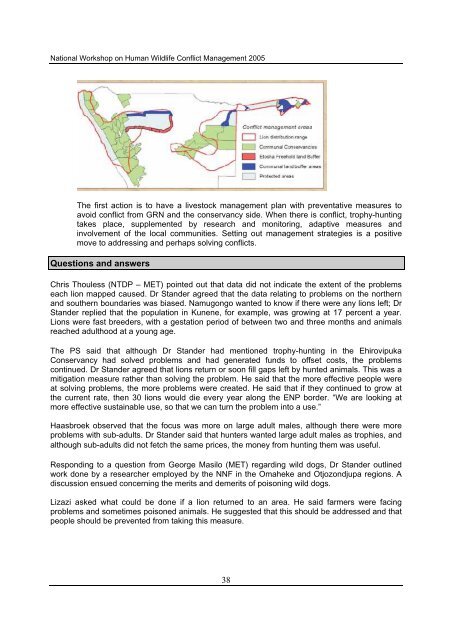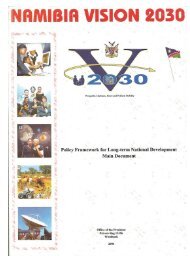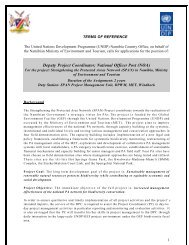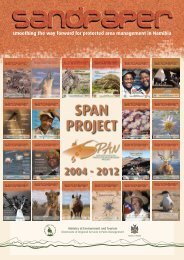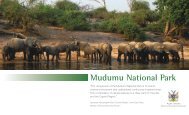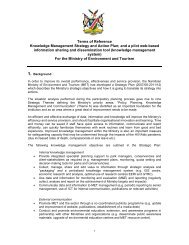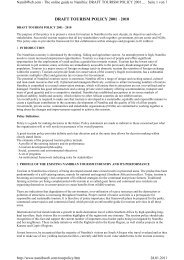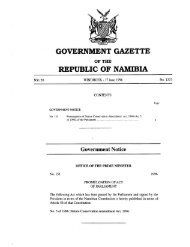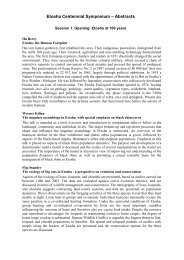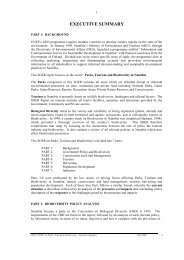HWCM - Ministry of Environment and Tourism
HWCM - Ministry of Environment and Tourism
HWCM - Ministry of Environment and Tourism
You also want an ePaper? Increase the reach of your titles
YUMPU automatically turns print PDFs into web optimized ePapers that Google loves.
National Workshop on Human Wildlife Conflict Management 2005<br />
The first action is to have a livestock management plan with preventative measures to<br />
avoid conflict from GRN <strong>and</strong> the conservancy side. When there is conflict, trophy-hunting<br />
takes place, supplemented by research <strong>and</strong> monitoring, adaptive measures <strong>and</strong><br />
involvement <strong>of</strong> the local communities. Setting out management strategies is a positive<br />
move to addressing <strong>and</strong> perhaps solving conflicts.<br />
Questions <strong>and</strong> answers<br />
Chris Thouless (NTDP – MET) pointed out that data did not indicate the extent <strong>of</strong> the problems<br />
each lion mapped caused. Dr St<strong>and</strong>er agreed that the data relating to problems on the northern<br />
<strong>and</strong> southern boundaries was biased. Namugongo wanted to know if there were any lions left; Dr<br />
St<strong>and</strong>er replied that the population in Kunene, for example, was growing at 17 percent a year.<br />
Lions were fast breeders, with a gestation period <strong>of</strong> between two <strong>and</strong> three months <strong>and</strong> animals<br />
reached adulthood at a young age.<br />
The PS said that although Dr St<strong>and</strong>er had mentioned trophy-hunting in the Ehirovipuka<br />
Conservancy had solved problems <strong>and</strong> had generated funds to <strong>of</strong>fset costs, the problems<br />
continued. Dr St<strong>and</strong>er agreed that lions return or soon fill gaps left by hunted animals. This was a<br />
mitigation measure rather than solving the problem. He said that the more effective people were<br />
at solving problems, the more problems were created. He said that if they continued to grow at<br />
the current rate, then 30 lions would die every year along the ENP border. “We are looking at<br />
more effective sustainable use, so that we can turn the problem into a use.”<br />
Haasbroek observed that the focus was more on large adult males, although there were more<br />
problems with sub-adults. Dr St<strong>and</strong>er said that hunters wanted large adult males as trophies, <strong>and</strong><br />
although sub-adults did not fetch the same prices, the money from hunting them was useful.<br />
Responding to a question from George Masilo (MET) regarding wild dogs, Dr St<strong>and</strong>er outlined<br />
work done by a researcher employed by the NNF in the Omaheke <strong>and</strong> Otjozondjupa regions. A<br />
discussion ensued concerning the merits <strong>and</strong> demerits <strong>of</strong> poisoning wild dogs.<br />
Lizazi asked what could be done if a lion returned to an area. He said farmers were facing<br />
problems <strong>and</strong> sometimes poisoned animals. He suggested that this should be addressed <strong>and</strong> that<br />
people should be prevented from taking this measure.<br />
38


